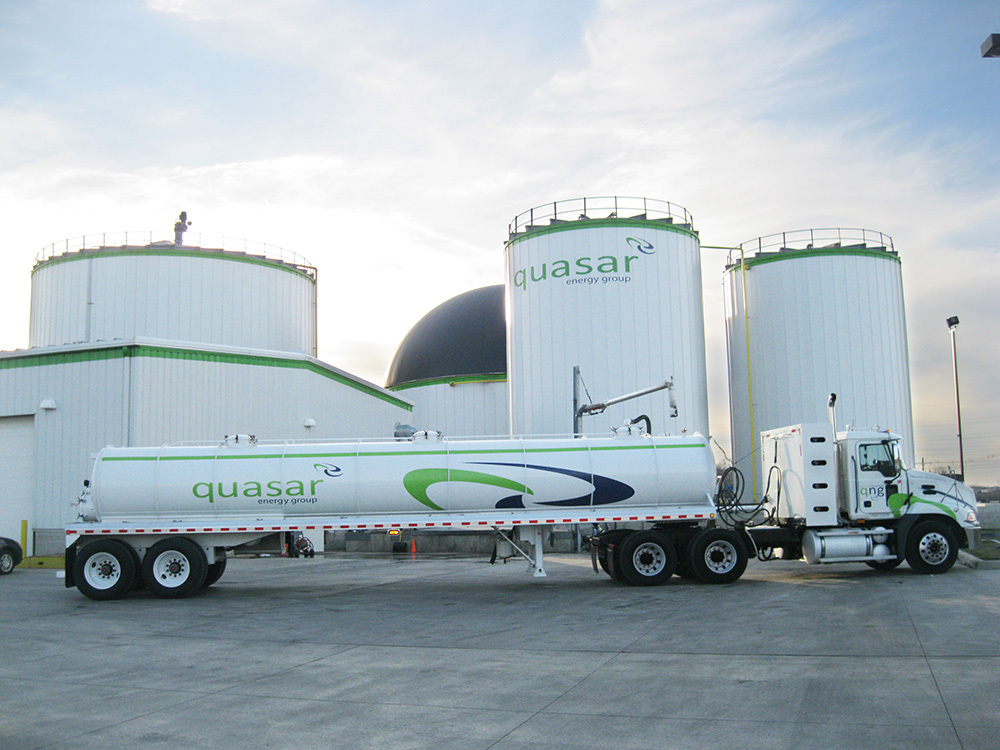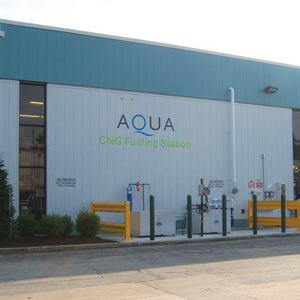Compressed Potential







Photo: Aqua America
September 24, 2014
BY Keith Loria
Biomass industry insiders agree that there are many good reasons to make the switch from gasoline and diesel fuel to renewable, compressed natural gas (CNG) or liquefied natural gas (LNG), but key to the continued expansion of the sector is the continued push for awareness outside of the industry.
CNG, which works best for short trips, is derived from organic waste and costs less than petroleum fuels, burns cleaner and produces less greenhouse gas. Meanwhile, LNG, which works with long-haul, on-highway Class 8 trucks, offers an energy density comparable to petrol and diesel fuels, extending range and reducing refueling frequency.
There are many programs set up to take advantage of incorporating biogas into transportation operations—big household names such as P&G and Owens Corning are incorporating natural gas into their transportation logistics—and an increasing number of companies specializing in assisting fuel switch. Mark Stoermann, director of operations for ampCNG, a Chicago-based energy company focused on displacing liquid fuels with CNG, says CNG is seeing increased acceptance as a lower-cost, domestically produced alternative to diesel fuel. “Since the introduction of the Cummins 11.9L 400HP engine, there has been a significant increase in both interest and purchases of CNG-powered vehicles for dedicated fleets,” he says. “The production of renewable natural gas from biogas is a proven way to reduce waste and produce a replacement for fossil fuels.”
AmpCNG converts large trucking fleets—for brands like Frito-Lay and Subaru— from diesel to CNG and, to support these operations, is also building a network of fueling stations for long-haul truck fleets throughout the country. “One of the biggest challenges in the growth of CNG as a low-cost, domestically produced transportation fuel is that there is currently limited fueling infrastructure,” he says. “AmpCNG partners with fleets to build ultrafast fill CNG stations that are located along their key routes and open to the public for fueling.”
William Zobel, vice president of market development and strategy at Chicago-based Trillium CNG, which provides CNG fueling solutions and equipment, including the proprietary Pinnacle line of hydraulic intensifier compressors, says there are a lot more natural gas vehicles available for purchase now than there were a year ago, with Ford, GM and Chrysler all expanding their lineups of natural gas-ready trucks. “The way that projects are being financed is also changing,” he says. “It used to be that municipal agencies would look to the federal government for funding, but now the government is strapped for cash, so they are turning to vendors and using public-private partnerships to finance natural gas transportation projects. The whole industry is moving very quickly in all aspects, not only with commercial trucks, but also with the mass transit and refuse sectors.”
Charlie Stevenson, fleet operations manager at water utility group Aqua America, says the company’s decision to invest in compressed natural gas to fuel its fleet was not a hard one. Aqua serves nearly 3 million people in Pennsylvania, Ohio, North Carolina, Illinois, Texas, New Jersey, Indiana and Virginia. In 2012, the company invested $130,000 in a time-fill station at its Springfield, Pennsylvania, operations center, and it’s grown since. Plans are also in the works to install time-fill stations at the company’s Willow Grove, Montgomery County, and West Chester, Chester County, operations centers. “We’re a green company and always look at all types of alternatives,” he says. “In fact, we bought our first CNG vehicle back in 1997. This time, we were looking at the stability of fuel pricing, and CNG has been pretty flatlined at around $2 per gas-gallon equivalent and it made sense.”
To date, the company has invested $675,000 in CNG through vehicle purchases and infrastructure upgrades, and it expects to have 90 CNG vehicles in operation within the next five years.
Patrick Serfass, executive director of the American Biogas Council, says there are lots of places where there should be focus on renewable and natural gas and the role biogas can play as a transportation fuel is an important one. “The main benefits come from the biogas systems themselves,” he says. “They not only produce renewable energy, but they recycle our organic waste, and in doing so, they help our soil, air and water. A lot of people scratch their heads and don’t understand how you can make motor vehicle fuel out of waste, and we need to build awareness.”
Advertisement
According to Serfass, natural gas fuel costs up to $1.50 less per gallon than gasoline or diesel, and the use of natural gas fuel not only reduces operating costs for vehicles, but also reduces greenhouse gas emissions up to 30 percent in light-duty vehicles and 23 percent in medium- to heavy-duty vehicles.
The state of Ohio is flexing its competitive muscle by considering legislation (HB 336 proposed by Reps. Michael O’Brien and David Hall) that would offer tax credits to residents and grants to public fleets for the purchase or conversion of alternative fuel vehicles. “Widespread use of CNG as fuel has the potential to significantly decrease the cost of transporting goods across the state, giving Ohio, a state rich in natural gas reserves, a big competitive advantage,” says Caroline Henry, vice president of marketing for quasar energy group in Cleveland, Ohio, which has three CNG stations open to the public in Columbus, Zanesville and Wooster.
Sam Spofforth, executive director of Clean Fuels Ohio, says there’s been an incredible amount of growth in Ohio for CNG, with a small increase in LNG facilities.
“Looking at it from the perspective of a station developer and a fleet, biogas is pretty cost-competitive with conventional natural gas in transportation applications,” he says. “It’s also very stable in price. You know what your costs are going to be, the cost recovery you will need and there’s consistency in feedstock values. And obviously, there are enormous environmental benefits with a tremendous net reduction in greenhouse gasses and the avoided methane emissions.”
Clean Energy, which focuses on both CNG and LNG, is planning to open several stations in the state in 2015.
Challenges Abound
When it comes to the expanded use of introducing biogas to transportation fuel, the biggest challenge is the availability of CNG fueling stations. According to the U.S. DOE, there are only 743 CNG fueling stations in the U.S., and just 58 LNG stations.
Henry says that the legislation being proposed in Ohio would encourage fueling station owners in Ohio to add CNG pumps to their locations in order to respond to the increased demand for alternative fuels.
Advertisement
Other challenges are the cost of anaerobic digestion, the biogas upgrading system and the ongoing operation of these processes.
Zobel believes financing biogas projects has been the biggest challenge, and it would help if there were government policies in place that could help further educate the public on the benefits that biogas brings, and financing backstops to ensure government incentives used to justify the investment will not evaporate with a change in administration. “Developers are looking for investors with a direct outlet for the gas to finance the project, but often these people don’t know enough about the project to make an informed investment decision,” Zobel says. “Some banks struggle too—it works on paper and there are case studies to prove it works, but most people just aren’t well-informed enough about it and the biogas manufacturing process is sensitive.”
Kevin Matthews, president of Genox Transportation, La Porte, Texas, which transports LNG with its fleet of 30 trailers, says the trucks being built today running off LNG are certainly better than those built just three or four years ago, but with so few stations available, it’s sometimes hard to keep things running. “With fuel being your second highest cost, and having the potential to save up to 40 percent, why wouldn’t you do it?” he says. “Many of the states are offering grants that allow you to buy trucks for roughly the same as you can buy a diesel truck.”
Stevenson says the fact that CNG can’t be used for long trips is also a challenge that keeps people away. “With our CNG vehicles, we can only get about 210 miles before they're out of fuel, so you really need to plan your trips accordingly,” he says. “When they go out, they come back from the same destination each day. Because of this, we can buy a slow-filling station, upwards of $150,000, as opposed to a fast-filling station, upward of $1.5 million, which keeps a lot of people out of the business.”
RIN Generation
Biogas is now eligible for RIN generation under the renewable fuel standard, an initiative that clearly helps offset the cost of biogas projects and brings more low-carbon fuel to the marketplace. Zobel says there is a certain number of cost elements that go into each project, and the RIN generation under the renewable fuel standard helps with the revenue side of things.
Stoermann adds transportation fuel, like CNG that is produced from biogas, has been approved for several years. “Renewable Dairy Fuels, a subsidiary of ampCNG has been issuing RINs since September of 2012,” he says. “The recent action of the EPA broadened the definition of the wastes that were eligible, and created a two-tier system of RINs that should increase the opportunity to recover the costs of producing a renewable transportation fuel.”
Quasar’s Zanesville and Columbus fueling stations are already approved under the RFS to generate RINs. According to Henry, the new rules will qualify anaerobic digesters processing biosolids and manure under a new category—cellulosic (or D3)—where previously these feedstocks were categorized under D5.
The RFS program changes are a big help to expanding the industry, Storemann adds. “Thousands of tons of waste are disposed of into landfills every year, and technology exists to convert this waste into energy. The key to making this happen is to offer a return to the companies that invest in this technology, and the expansion of the RIN program by the EPA is a step in the right direction.”
Author: Keith Loria
Freelance writer, Biomass Magazine
freelancekeith@gmail.com
Upcoming Events





